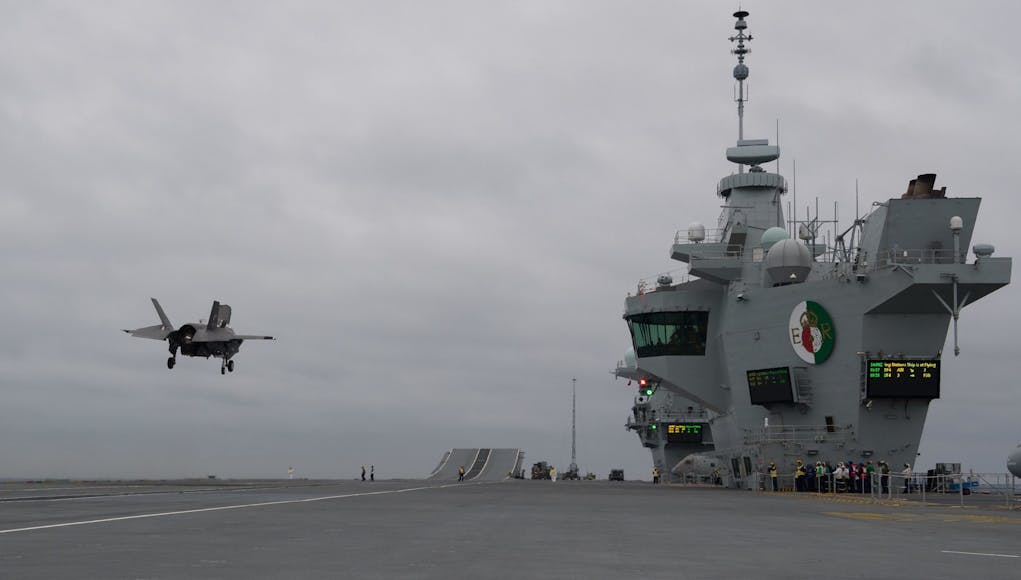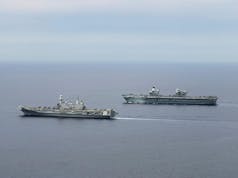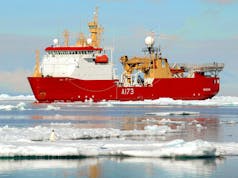The U.S. Naval Air Traffic Management Systems Program Office completed Precision Approach and Landing System (known as PALS) certification on HMS Queen Elizabeth in March, completing a critical step in readying the ship for its first operational deployment.
The PALS system includes the AN/SPN-41B Instrument Carrier Landing System (ICLS), previously installed by PMA-213 as a foreign military sales (FMS) effort, and the AN/USN-3 Joint Precision and Approach Landing System (JPALS) system, installed as a U.S. asset to support the future embarkation of Marine Fighter Attack Squadron (VMFA) 211’s F-35Bs aboard HMS Queen Elizabeth during its inaugural operational deployment.
“The early phases of the installation were supported remotely by the Naval Air Warfare Center Webster Outlying Field (NAWCAD WOLF) Air Traffic Control and Landing Systems (ATC&LS) Division. Once the initial installation activities were completed, the NAWCAD WOLF team, led by Shawn Magoon, travelled to the United Kingdom in early February to finalize the installation and support the certification, but first had to overcome a few challenges.”
The team faced heightened U.K. coronavirus travel restrictions, unique policy questions concerning the installation of the JPALS system on HMS Queen Elizabeth, and even “a case of lost luggage, according to the U.S. Navy.
Capt. Kevin Watkins, U.S. Naval Air Traffic Management Systems programme manager.
“It truly is a testament to the individual determination, communication and leadership that all of our teammates embody, because each of these ship installs and certs was incredibly difficult, with barriers from COVID travel restrictions to first-time technical installation issues on a new ship class. Our team successfully overcame each daily challenge to deliver the needed capability to our International Allies and U.S. Marines.”
The NAWCAD WOLF team was joined by members of Naval Test Wing Atlantic ATC&LS Test Branch, Air Test and Evaluation Squadron (VX) 23 to complete the at-sea portion of the certification.
The ATC&LS Test Branch is the certification authority for all U.S. ships, and in this case for the U.S.-owned JPALS installed aboard the British aircraft carrier, while also supporting certification recommendations for FMS installed systems.
The success of the installation and certification of the JPALS and SPN-41B systems aboard HMS Queen Elizabeth was due to the close collaboration between PMA-213, NAWCAD WOLF, VMFA-211 and their U.K. counterparts, Watkins said.














I’ll bet it was a nightmare of compartmentalisation (is that a word?). The US Techs would be very protective of “their” technology. I worked with the US Sate Dept. and LM techs on another project, there was a lot of “we can’t tell you that”. Still, nice to see what can be achieved when folks put their minds to it!
So who fixes it, when it breaks?
Who do you think, donut?
Ah, so there’s going to be a contingent of USN permanently embarked….;)
Or, even better, OEM contractors for a bit of extra pork…!
Another reason why we should never be in this sort of project again. US always protects its tech but wants other nations to share theirs.
Paranoid much?
You just made my argument for me. USA is paranoid of sharing its tech with others but expects others to not do the same. At least have a drop of intelligence if you are going to make an empty snarky comment.
Indeed and its not like there isn’t plenty of evidence of it going on back at least as far as the Miles M.52 in the 40s when US experts were allowed to inspect it while the supposed corresponding promised visit by UK experts to the Bell transonic efforts for some reason just could never be fitted into the timetable. The rest is history.
Oh, its even worse than that. Manhattan, Tube Alloys and the McMahon Act…
LeMay refused Penney a seat as an observer on Enola Gay and Bockscar after we shared our know-how with them
Indeed. There is a long history of America expecting others to share their research and tech but nothing worthwhile comes back.
If only more people woke up and saw the fact that this ‘special relationship’ only goes one way. We should be aligning with our child-nations, AU, NZ and CA.
America has interests/associates, it doesn’t have friends.
Surely it would have been cheaper and easier to just velcro some crayons to the deck where you want the jet to land. US Marines love crayons……
Not sure I get this. Are USMC F35B using a different technology than UK F35B that needs different supporting equipment? Does that mean they won’t be doing SRVL to land on the carriers? That all sounds very painful.
Interesting question – while SRVL is an option for RAF/FAA F35’s i don’t think it will be SOP for USMC ones,it might be the case that this Equipment is more Compliant with the way the USMC Operates.HMS POW also has the Bedford Array,will that mean that she won’t need this Equipment Fitted at all ?.
If they don’t use SRVL, then its going to constrain their landing weights, etc which would seem to be less than optimal (maybe they care less about the costs of dumping unused ordinance!).
I’d have thought SRVL would have been a valuable option even on the USMC carriers.
There has not been a lot of info released about the success of the SRVL trials. I wonder if in practice it is worth the risk of using it that often? Presumably most launches will not require that much ordinance to be carried. On the assumption that there is some risk given the lack of arrestor cables and an angled flight deck then any “bolter” that goes over the side or runs into something else on a congested flight deck could easily run up costs into the hundreds of £m. You need to be able to save a lot of ordinance costs to justify that risk/reward ration…..
I expect this is certification related. Either the USMC aren’t certified to use the British system, or they need to do a certain number of landings using the US system to remain certified on that, or some other bureaucratic box ticking.
Why would an aircraft that lands vertically need a precision approach system? Doesn’t exactly need to follow the usual three degrees or so. And SVRL is a British invention, so no need for any US stuff. Slightly confused.
On a separate note, the MoD have finally published that they are purchasing 14 Chinook Model Gs. These will be used to keep the fleet to around 60 aircraft. With the very early aircraft either sold on or pensioned off.
These look pretty useful too!
https://euro-sd.com/wp-content/uploads/2019/06/A-USMC-CH-53-SUPER-STALLION-lifts-a-RCAF-CH-47-CHINOOK.-247×300.jpg
Could we not produce something like this here in Europe?
https://euro-sd.com/2019/06/articles/13789/chinook-or-king-stallion-heavy-lift-helicopter-alternatives-for-europe/
Only if Airbus buys shares in Mil ( half joking ).
As Leonardo, own Westlands, they already have a comparative design with the Rotodyne. It had the same lifting capacity as the Model A Chinook used during Vietnam, but went a hell of lot quicker.
With modern materials and technology, it could rival both the Chinook and Sea Stallion for lift. But perhaps more significantly could offer double the speed and range!
Many thanks for the info, quite an impressive helicopter. As you quite rightly say, with modern materials and technology, it could rival both the Chinook and Sea Stallion for lift, range and speed!
“The Rotodyne was publicly displayed at the renowned Farnborough Air Show in 1958 and ’59, impressing both commercial and military observers.
Fairey emphasized its safety—it could hover with one engine shut down, and the prototype demonstrated several airplane-like landings as an autogyro.
On January 5, 1959, it blew away its speed requirement, setting a world speed record in the “convertiplane” category, at 190.9mph (307.2km/h), over a 60-mile (100km) course.
In June of that year, the Rotodyne flew a load of passengers from Heathrow Airport to the 23rd Aeronautical Salon in Paris with stops in Brussels and Issy Heliport in Paris. It cruised at 180mph (289km/h).
Fairey flight test engineer (later chief engineer for Westland) David Gibbings recalled in a BBC documentary called The Golden Age of Flying how effortlessly the Rotodyne flew: “It leaped off the ground and into transition as if it had done so a thousand times. You didn’t feel it was a faltering, ‘Let’s see how it goes this time chaps’ affair. It was confident in the extreme.”
https://arstechnica.com/cars/2020/02/the-fairey-rotodyne-the-vertical-take-off-and-landing-airliner-time-forgot/
For more information try the following book: Fairey Rotodyne by David Gibbons. This has not only the reasons for the aircraft, but also the cancellation reasons. It has a lot of technical detail and there’s a section by the chief test pilot on how easy it was to fly and transition from the hover to forward flight and back again.
The Army/RAF were really short sighted and the Minister of Aviation, Sir Peter Thornycroft, who cancelled the development should also be hung.
Many thanks, I’ll try to locate it.
“Installed as a U.S. asset”.
Do we put our landing systems on the WASPs ?
So our carriers are theirs to do with as they wish, then…
The USN does love its paperwork.
When working on USN vessels even the most simple of jobs needs a mountain of paperwork such as, check points that are done by one of 3 levels of inspection, completion certificates , condition found reports, contract amendments, Process Documents, Wiring certification, welding certification, pipe blanking certification, pressure testing, painting and coatings…
Then at the end a completion certificate and more paperwork to say you have done all of the paperwork or to note that it is incomplete because of outstanding trials etc…
I am sure that the USN is one of the major reasons for deforestation…